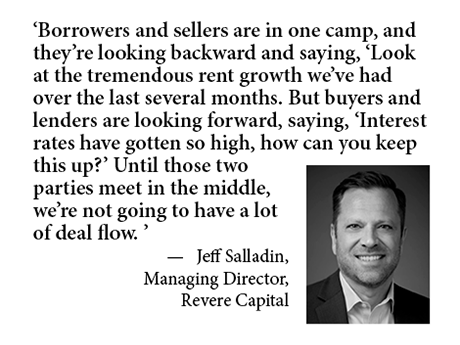As the pandemic lockdowns hammered offices and retail properties, investors abandoned those assets and plowed cash into apartments and warehouses, both of which witnessed robust rent growth and appreciation as the economy reopened.
But in many cases, apartment investors tapped ultra-cheap, variable-rate financing to overpay for multifamily properties, expecting rental rates to continue to climb and help the deals pencil financially. While in large part rents have grown — albeit not at the same double-digit level seen during 2021 and early 2022 — buyers often made the deals with too much optimism and failed to account for potential risks or often, at least, underappreciated them.
Now, not only has the debt on those multifamily assets become considerably more expensive in about a year’s time, but labor, insurance, taxes and other operating costs also have increased. As a result, financial cracks are emerging in the multifamily market, says Jeff Salladin, a managing director with Dallas-based private debt fund Revere Capital.
What’s more, because of the typical 12-month apartment lease term, landlords are unable to pass those higher expenses onto tenants in a timely fashion, declares Salladin, leader of the firm’s real estate debt team. Even if multifamily owners could increase rents, the 1.1 percent in annual hourly earnings growth in July as calculated by the U.S. Bureau of Labor Statistics was below the annual inflation rate of 3.2 percent for the month, meaning that renters may have a hard time absorbing additional costs.
“Multifamily properties are starting to suffer,” he observes. “The question is, how quickly can you pass these increases onto tenants, especially if tenants are not getting raises?”
Standoff Continues
Compounding this adversity is a decline in property values, due chiefly to the Federal Reserve’s monetary tightening policy that began in early 2022. Since then, the Secured Overnight Financing Rate (SOFR), a benchmark for variable rate loans, has ballooned to 5.3 percent from near zero, while the 10-Year Treasury yield has more than doubled to around 4.1 percent.
Over roughly that same period, apartment prices have dropped 21 percent from their most recent peak, according to Green Street, an independent commercial real estate research firm based in Newport Beach, Calif. Meanwhile, a sharp downturn in investment sales amid a bid-ask standoff is obstructing true price discovery, Salladin notes.
“Borrowers and sellers are in one camp, and they’re looking backward and saying, ‘Look at the tremendous rent growth we’ve had over the last several months,’” he explains. “But buyers and lenders are looking forward, saying, ‘Interest rates have gotten so high, how can you keep this up?’ Until those two parties meet in the middle, we’re not going to have a lot of deal flow.”
Buyers have good reason to hesitate if sellers are still trying to fetch a price that was the norm 18 months ago. As an example, Salladin says, a borrower who paid $12 million for a multifamily asset a couple of years ago has likely seen its value drop to around $10 million. If the borrower took out a $9 million loan, the size of that loan has jumped to 90 percent of the value from 75 percent, he continues, which will make refinancing next to impossible and heightens default risk.
“The borrower is going to have to either fill that gap — either by coming out of pocket or finding mezzanine financing or preferred equity — or give it back to the bank,” Salladin points out. “Banks could also get more aggressive with a new type of product or be willing to increase their loan-to-value limits. But right now, many borrowers are working with their lenders to get extensions to keep the clock running and hope for the best.”
Looking for a Sign
Regulators appear to be encouraging the latter behavior. In June, the Federal Deposit Insurance Corp. (FDIC), the Fed and other agencies encouraged banks to work with credit-worthy borrowers in times of distress by reiterating and updating guidance originally introduced in 2009. Among other discussions, the regulators recognize that banks may need to provide simpler short-term accommodations before a loan is ready for a complex, long-term workout.
Such a policy suggests that regulators and the market are satisfied allowing the market to limp along. Still, transactions have ticked up heading into what is typically the busiest period of the year, Salladin reports. But if the Fed were to provide guidance as to when it might stop raising interest rates — or even when it might begin cutting them — it could inject some needed clarity into the market.
“There’s a feeling that the damn is starting to break a little bit,” Salladin remarks. “But it’s hard to tell whether it’s ordinary seasonal activity by brokers and acquisition people trying to meet their quotas or whether it’s an actual return to some sense of normalcy. It’s just too early to tell.”
— By Joe Gose. Revere Capital is a content partner of REBusinessOnline. For more information about the content partner program, click here.
The information contained in this article is not intended, and should not be construed, as investment advice and does not constitute an offer or commitment, a solicitation of an offer, or any advice or recommendation, to enter into or conclude any transaction.


